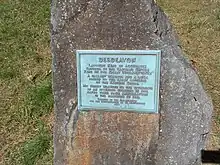| Total population | |
|---|---|
| extinct as a tribe[1] | |
| Regions with significant populations | |
| Virginia | |
| Languages | |
| unattested Eastern Algonquian language | |
| Religion | |
| Indigenous | |
| Related ethnic groups | |
| Powhatan Confederacy |
The Accomac people were a historic Native American tribe in Accomack and Northampton counties in Virginia.[1] They were loosely affiliated with the Powhatan Confederacy.[1]
The term Accomac was eventually applied to a larger group of related Indigenous peoples living on the Eastern Shore of Virginia. To the north, the Eastern Shore of Maryland was home to the Pocomoke and related tribes, such as the Annamessex.[2] Further north, the Assateague people lived on the Atlantic Coast of Maryland and Delaware.[3]
History

Their primary settlement, also called Accomac, was near present-day Cheriton, Virginia, on Cherrystone inlet in Northampton County.[1]
Debedeavon (Accomac, died 1657) was the principal chief of the Accomac when English colonists first arrived in 1608. They called him the "Laughing King" and allied with him. In 1608, they were recorded as having 80 warriors.[1]
By 1700, the Accomac population had declined by approximately 90 percent due to introduced diseases such as smallpox and violence from the colonists.[4] The colonists began calling all American Indians to the immediate east of Chesapeake Bay "Accomac."[1] They maintained communal lands through 1812, mostly in and near Accomack County.[1]
A subgroup, the Gingaskins, lived near present-day Eastville, Virginia. They intermarried with African Americans living nearby. After the Nat Turner's slave rebellion of 1831, local White Americans forcibly expelled them from their homelands.[1]
Subtribes

Subtribes of the Accomac included the following groups:
- Acohanock, also written Accohannock
- Anancock, Oanancocke, Onancock
- Chiconessex, Chicconessick
- Combec
- Gingaskin, Gangascoe, Gingaskoyne,
- Kiquotank, Kikotanke
- Matchapungo, Machepungo, Mastiapungo, Matchopungo,
- Macheteege
- Mashawatoc
- Matomkin, Matompkin, Motomkin
- Nadue, Nandewy, Nanduye
- Occoahannock
- Pungotege, Pungoteque.[5]
Name
Philologist James Hammond Trumbull wrote that Accomac means "the other-side place" or "on-the-other-side-of-water place."[6] Alternative spellings include Accawmacke, Accomack, Accowmack, Acomack, and Acomak.[1]
Cultural heritage group
Maryland designated the Accohannock Indian Tribe as a state-recognized tribe in 2017.[7] They claim to be descendants of the Accomac people; however, historians and other Native American tribes dispute those claims.[7]
See also
Further reading
- Helen C. Rountree. Pocahontas's People: The Powhatan Indians of Virginia Through Four Centuries. Norman: University of Oklahoma Press, 1990. ISBN 9780806128498.
- Weslager, Clinton Alfred. The Accomac and Accohannock Indians from Early Relations. Cape Charles: Hickory House, 2001. ISBN 1886706522.
Notes
- 1 2 3 4 5 6 7 8 9 Frederick Webb Hodge, Handbook, 8.
- ↑ Christian F. Feest, "Nanticoke and Neighboring Tribes," 240–41.
- ↑ Christian F. Feest, "Nanticoke and Neighboring Tribes," 241.
- ↑ Christian F. Feest, "Nanticoke and Neighboring Tribes," 242.
- ↑ Christian F. Feest, "Nanticoke and Neighboring Tribes," 248.
- ↑ Frederick Webb Hodge, Handbook, 7.
- 1 2 Tkacik, Christina (11 February 2018). "Maryland recognition of Accohannock tribe sparks debate within community of Native Americans". baltimoresun.com. Archived from the original on 23 October 2018. Retrieved 12 February 2018.
References
- Hodge, Frederick Webb (1911). Handbook of American Indians North of Mexico. Washington, DC: Smithsonian Institution.
- Feest, Christian F. (1978). Trigger, Bruce G. (ed.). Handbook of North American Indians: Northeast, Vol. 15. Washington, DC: Smithsonian Institution. pp. 240–48.